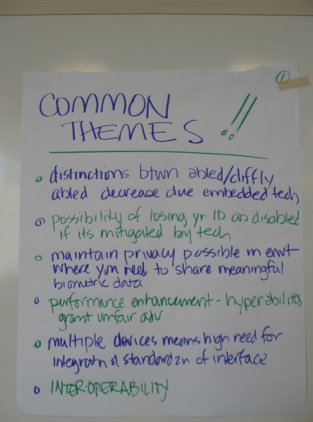
To close out day one of the Summit and digest all of the information received and exchanged throughout the day, Summit participants brainstormed a list of common themes across all presentations. They included:
- Distinctions between the abled and the differently abled decrease due to embedded technologies.
- Possibility of losing your identity as a disabled person if your disability is mitigated by technology (is someone with a cochlear implant still deaf?).
- Is maintaining privacy possible in an environment where you need to share biometric data for meaningful health output / results.
- Re: performance enhancement – will hyperabilities grant an unfair advantage to the (former) “disabled”?
- Multiple devices addressing different disabilities suggest a high need for integration and standardization of interfaces.
- INTER-OPERABILITY!
- Limits to integration – should be self-determined.
- Whatever tech solution is in play there will be a second consciousness there to assist – development of a new “AI”: an assistive intelligence.
- Tech as partner to individuals, but also remember that individuals are embedded in a community: tech solutions need to fit the individual, but also work well within and for the individual’s community.
- Too little sensitivity to questioning the need for technology before developing it. We should be asking what SHOULD we do with technology, not what COULD we do with technology. We need a balance.
- Certain skills – we’ll lose if we don't use them.
- We should optimize the health and capability of the baseline human FIRST.
- Should have the ability to select how much capability / disability you want enhanced / mitigated
- AUTONOMY – understand user preferences not just their needs – users need to guide what trade-offs are made.
- Challenge for the education and training of care-givers to create the best environment of support by choosing appropriate assistive technologies (hardware, software, orgware).
- “Digital divide” – few of the papers addressed either the differentials in access due to expense or to the education required for choosing and using assistive technologies.
- Transparency >> these technologies should be transparent, usable, affordable (design parameters).
- Human agency >> often people don’t know their preferences in advance, before playing with the options on offer. It’s why pro-sumption (production by consumers) and co-design and co-tinkering are critical.
- Will wearable devices be collecting data for us, about us, about our environment – rather than us engaging the world with our own in-built senses?
- Will medical advances cause problems for assistive technologies, as innovations surge ahead while ethics and values lag behind?







